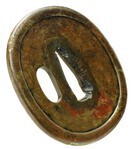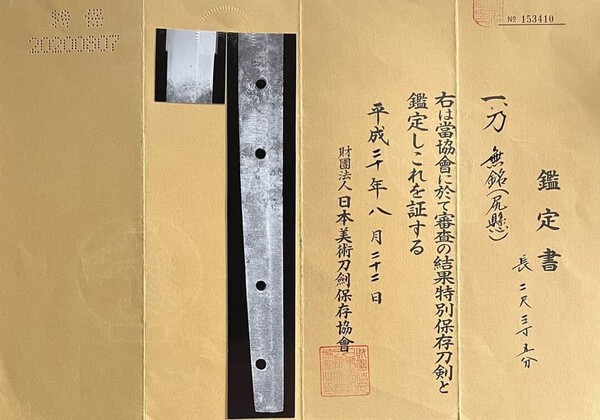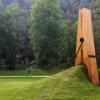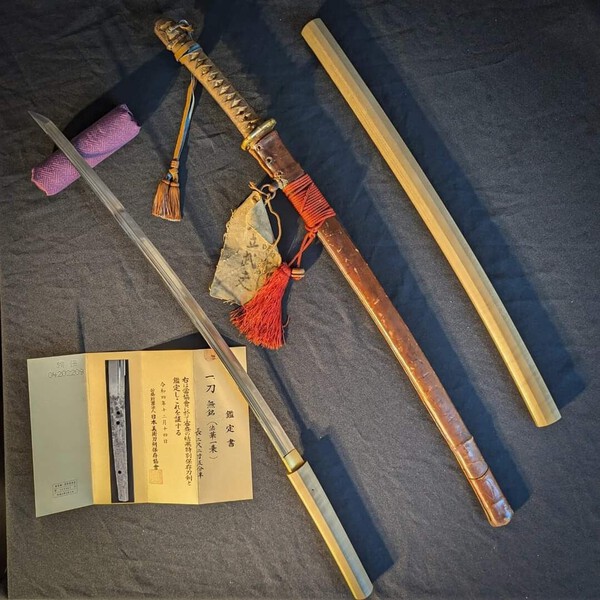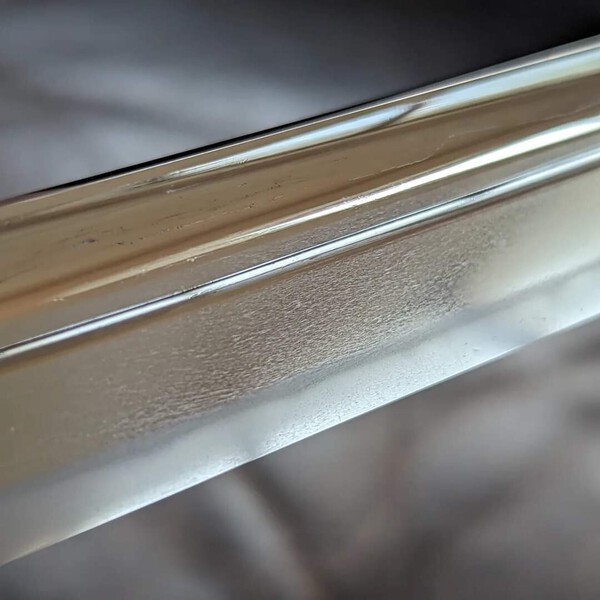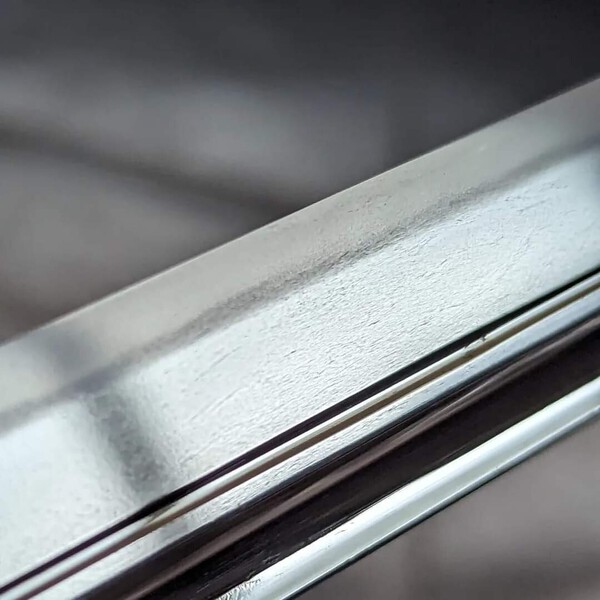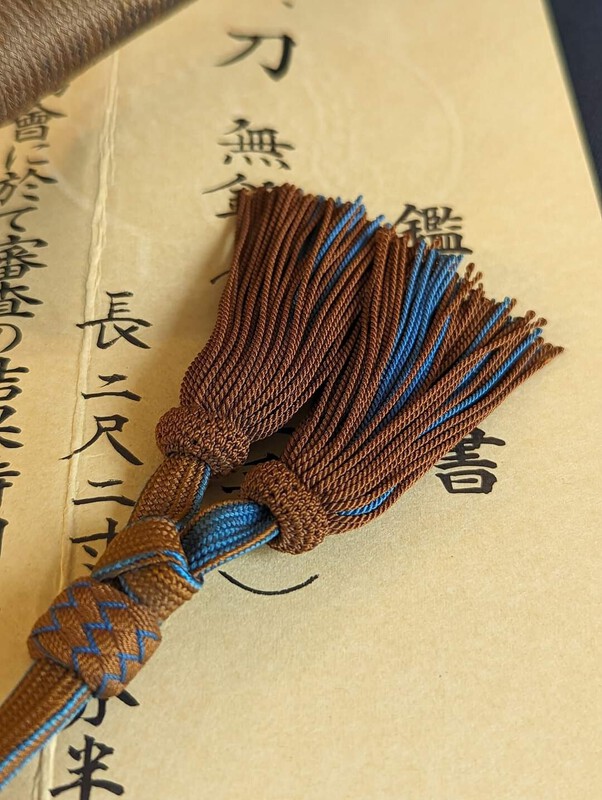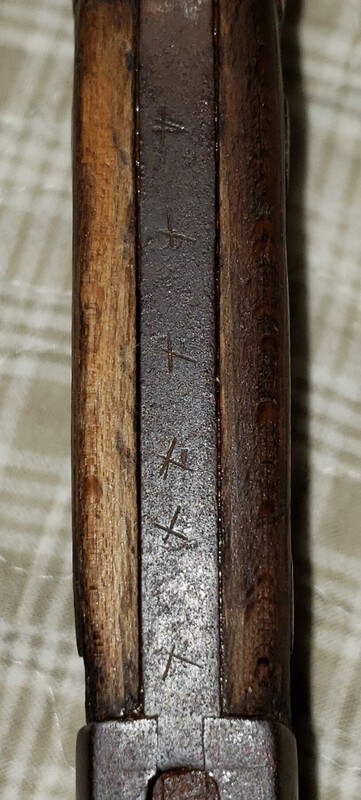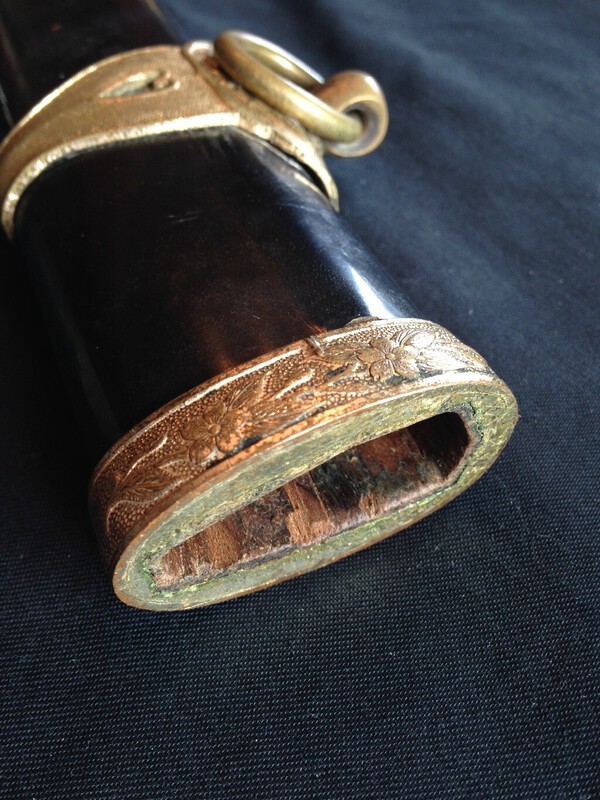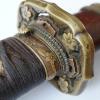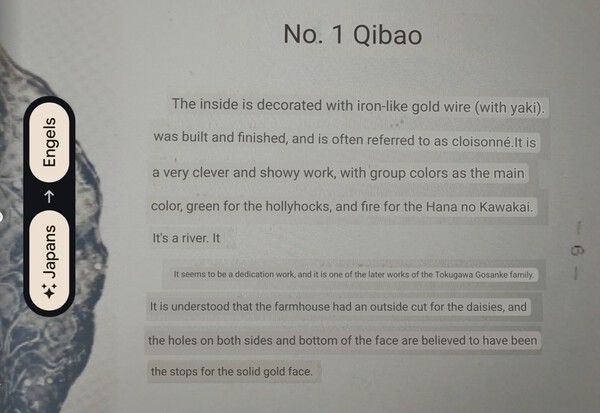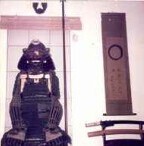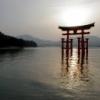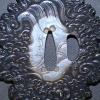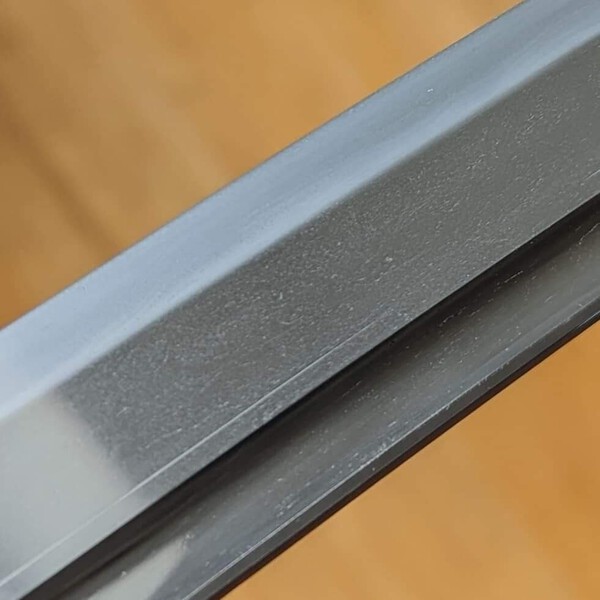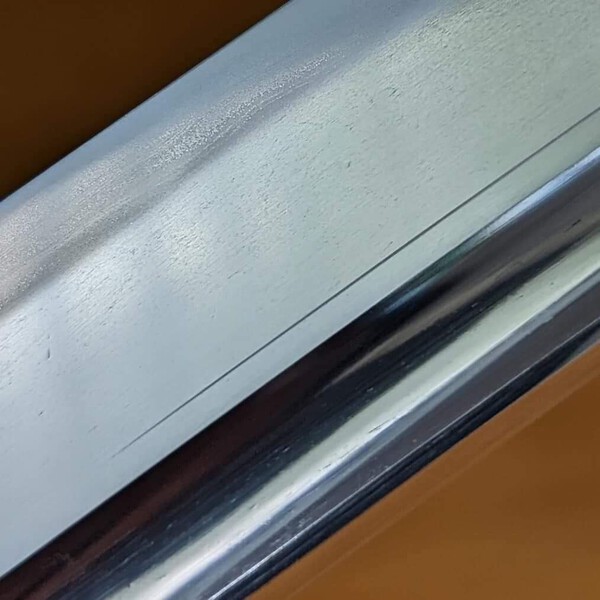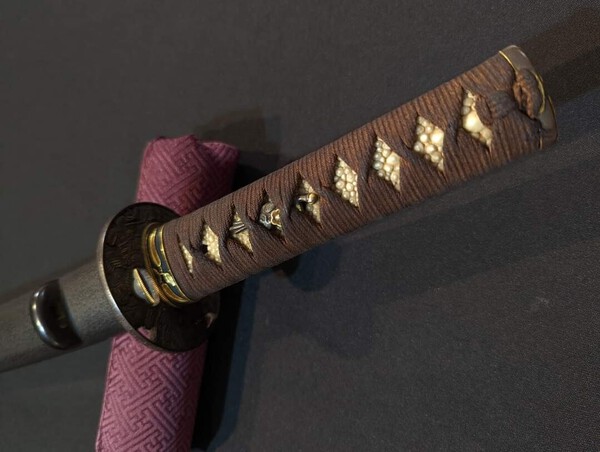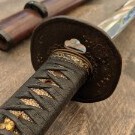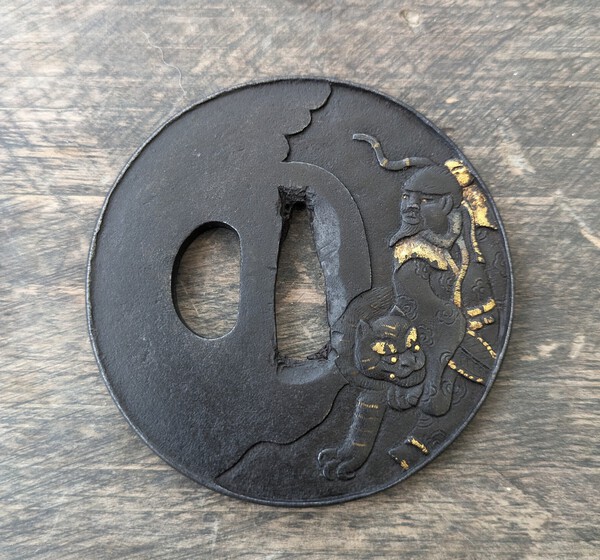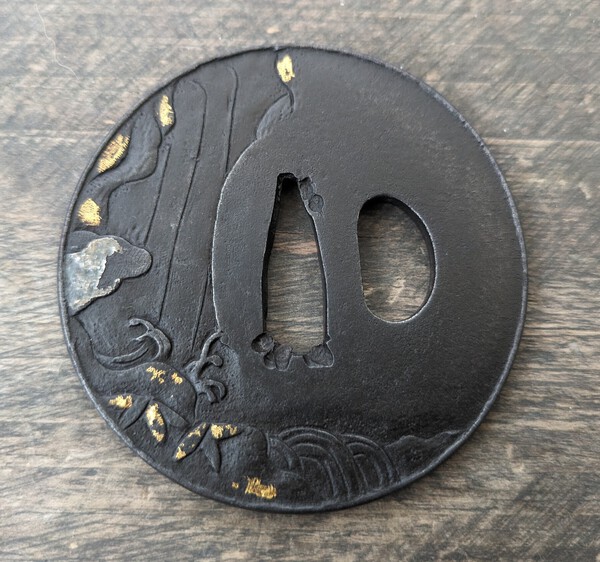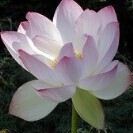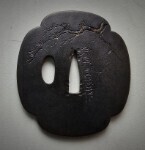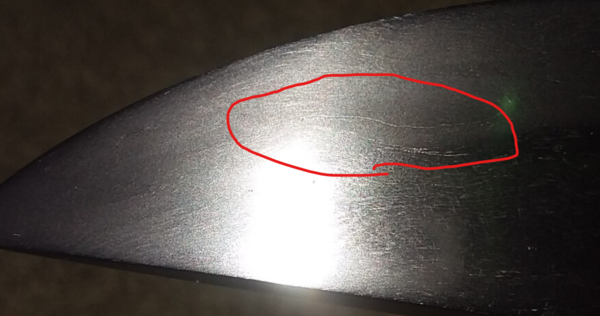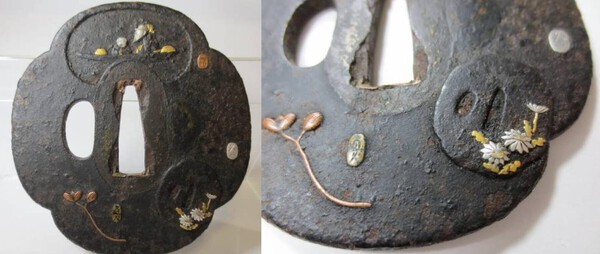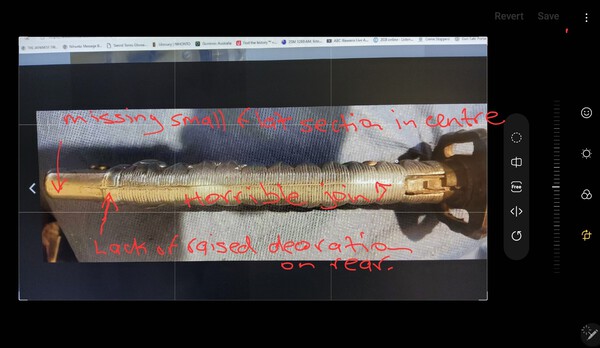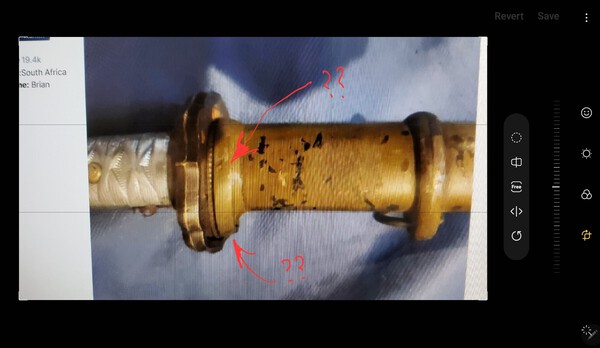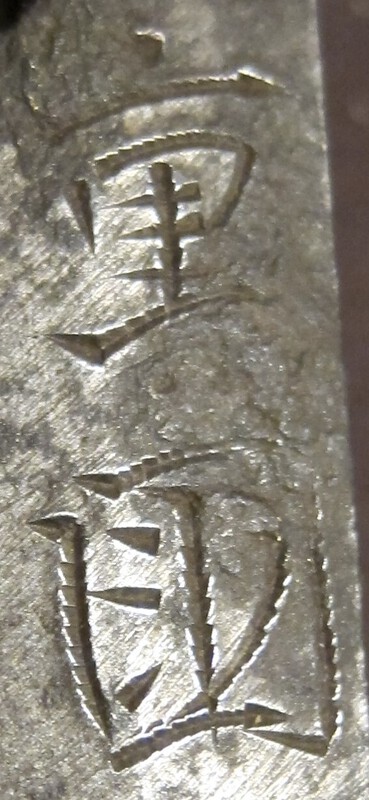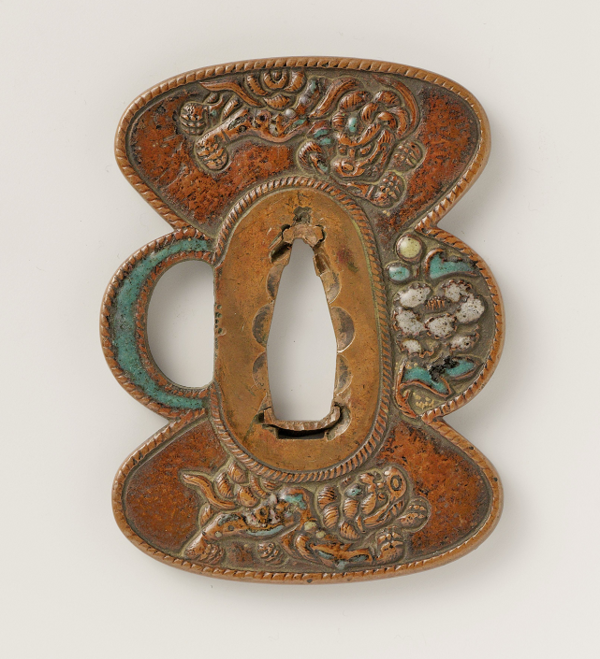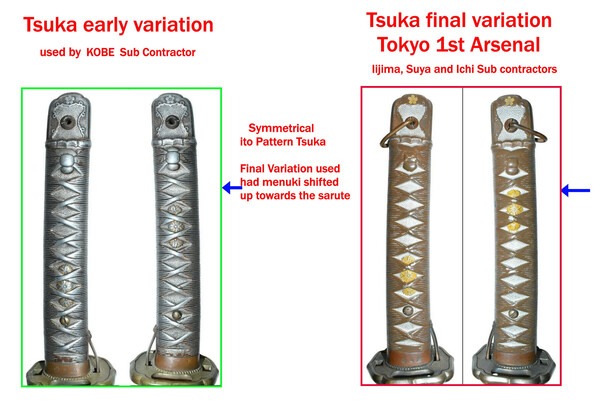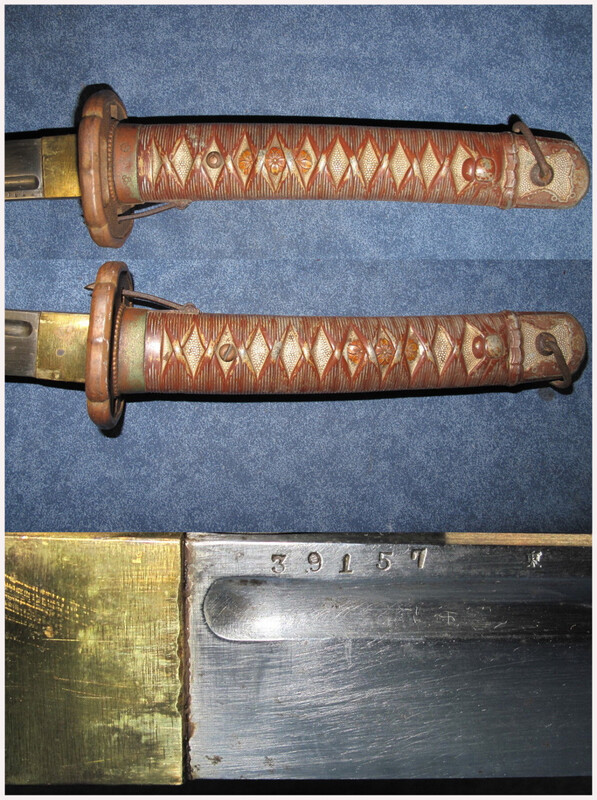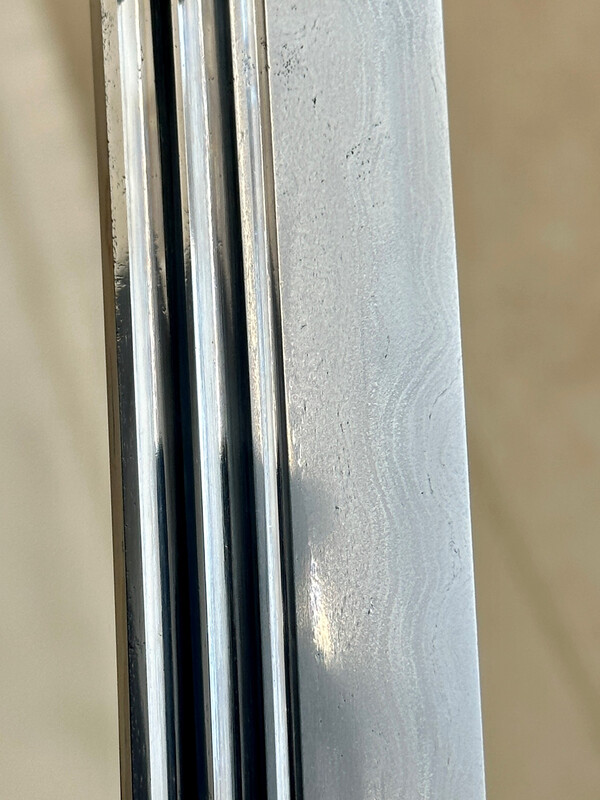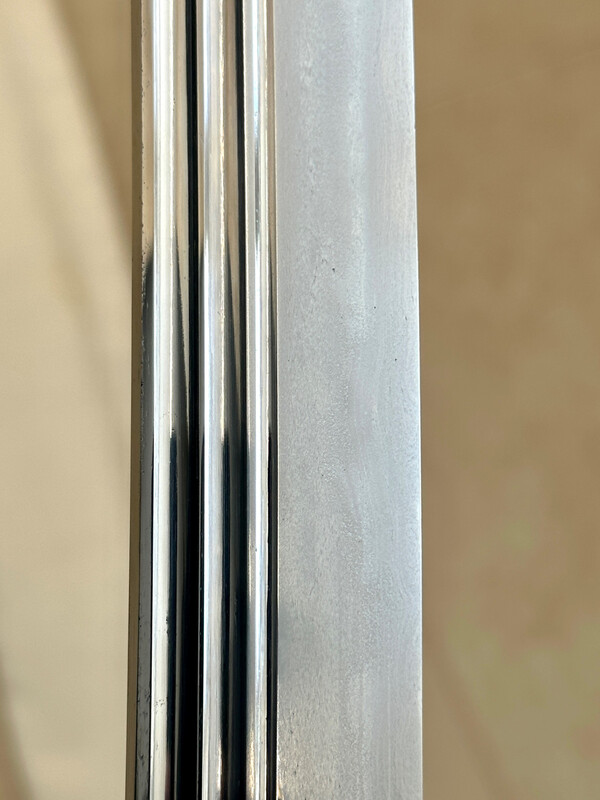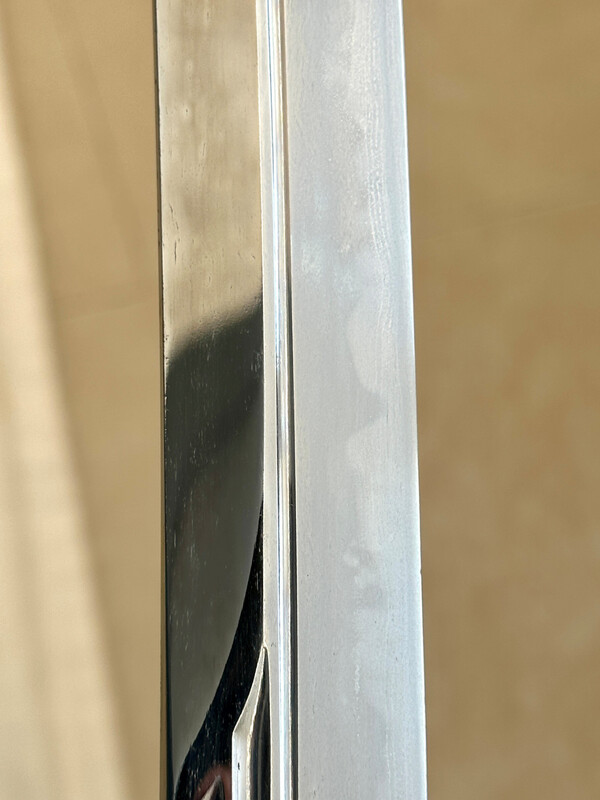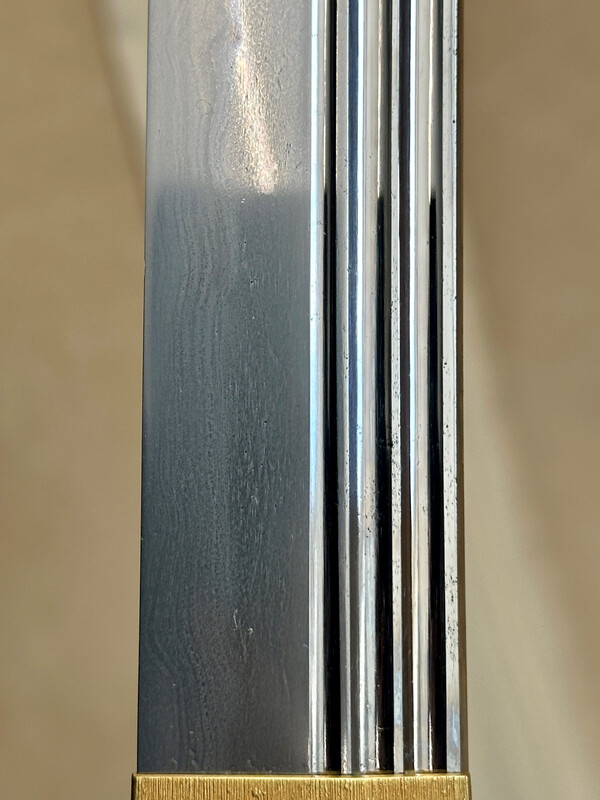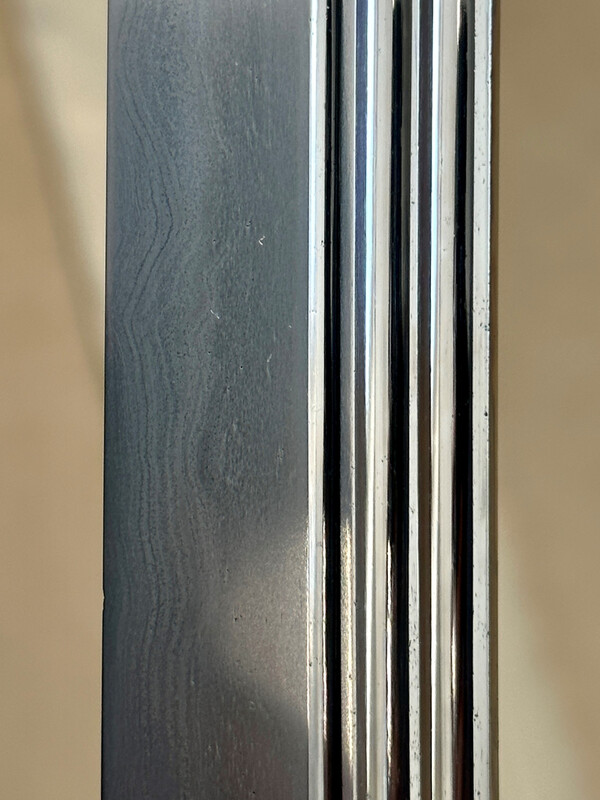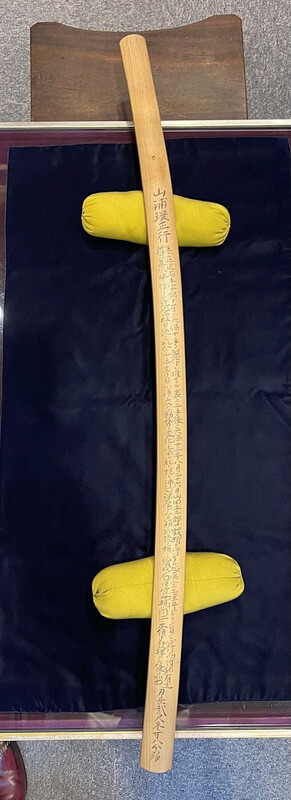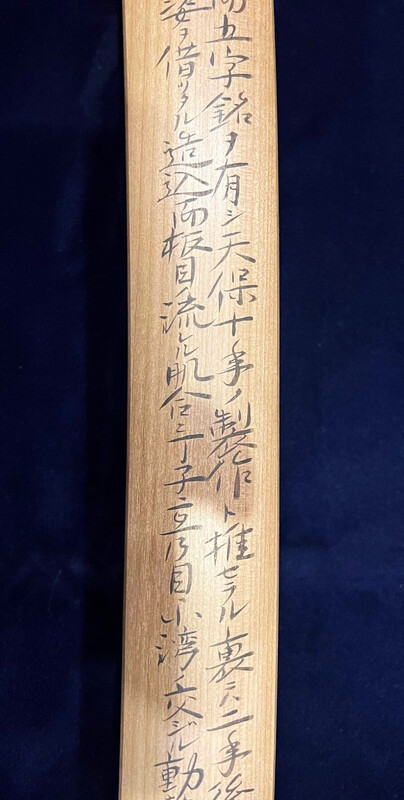Leaderboard
Popular Content
Showing content with the highest reputation on 03/08/2024 in all areas
-
Hello Andrew, I've got good news and bad news: The bad news: I'm afraid this isn't a WW2 sword. The good news: It dates from several centuries before WW2, potentially from the 1600s. The inscription is 近江守藤原継 (cut off) Ōmi-no-kami Fujiwara Tsugu... (cut off, but probably Tsuguhiro) It means 近江守藤原継廣 Ōmi-no-kami = Lord of Omi Province (Omi province is present-day Shiga Prefecture in Japan. Fujiwara = this is a clan name. Not really to be taken as a literal name of the swordsmith. Its the swordsmith declaring he has a lineage to an ancient aristocratic clan. Tsuguhiro = is the swordsmith's name. Not his real, given name, but more or less a professional name. Your sword was originally longer by a few inches, but it was cut down at some point. Shortening the sword is very common. It was always shortened from the tang. So the tang was shortened, and the notches where the brass collar sits were moved up. Could have been done a couple of hundred years ago, or a hundred years ago. There are many swords with fake signatures, and yours too could have a fake signature. Faking signatures was (and still is) very common. Regardless, the sword itself is still a genuine Japanese antique, and could still be several hundred years old even if the signature turns out to be fake. So what I'm saying is, the sword should be preserved, shouldn't be subject to any amateur restoration efforts, and is probably worth showing to someone who knows a lot about swords. It will be hard to authenticate it just by looking at photos. And, the condition probably precludes anyone from making an accurate assessment. But, as I said, the sword is a genuine antique regardless of the authenticity of the signature.7 points
-
Nambokucho O-Suriage Tachi NBTHK Tokubetsu Hozon to Shikkake school One of the 5 schools of the Yamato Den 71.2 cm with a 23 cm Nakago. This would have been a massive Tachi before O-Suriage . Solid gold Habaki Sayagaki by Mr. Tanobe : This sword is O-Suriage museum.The omote shows an itame mixed with Nagare and Madame. The ura side features some ji-nie.The hardening in suguha is nie- laden and is interwoven with uchinoke and got sure, and the hakikake in the Boshi. We reorganize the characteristic features of the Yamato tradition the connected gunome that appear in places resemble doe-yakiba ,with that this masterwork can be attributed to the Shikkake school. 20214 points
-
The residue might be cosmoline, or might be some old oil. Either way, I would remove it from the sword with denatured alcohol and a soft cloth. If you have any lens-cleaning cloths (like for cameras or glasses), those will work very well. Clean off the old oil, then put a very thin layer of lightweight oil (sewing machine oil or electric shaver oil) on the sword to stop it from rusting. You don't need to drench it in oil. A tiny film of oil will be fine. The wooden scabbard (called a shirasaya) is a plain scabbard used for storing the sword, and they are still made and used to this day. We all store our swords in them. Yours is well past its "use by" date, so at some point you should get a new one made. (You don't want an antique sword resting in a scabbard that has a hundred years of old grime and oil and dust and muck in it). If yours is clean inside, and just has tape residue on the outside, it should be OK to continue using for now. Also OK to tape it back up so that it actually works as a protective case for your sword. These things are meant to be renewed when they start getting dirty and falling apart. If it has some old writing on it, you'll want to preserve it, but if its just a plain, dirty, wooden scabbard that's falling apart, it's OK to tape it back up and use it until you can get a replacement made. The sword looks to be just under 24 inches from tip to notch, so it's right on the border between "wakizashi" size and "katana" size. These are the official size designations used by Japan today. Anything over 60.6 cms is classified as katana, and anything 30.3 cm - 60.6 cm is classified as a wakizashi.4 points
-
4 points
-
Yes, If the sound you are referring to is the lovely silence of blade sliding on wood, then we understand! But if you mean Hollywoods notorious "Schwingggg", then that, my friend, is pure fiction. This is the only diagram I have, there may be better one's out there: Here is a photo of one of my mantetsu with the liner out.3 points
-
3 points
-
3 points
-
Dear Joseph. If the crack is sharply defined, almost geometric then be concerned. If it meanders then it might well be a forging lamination that you are seeing and no cause for concern. All the best.3 points
-
This is a quite spectacular and healthy koto daito with Tokubetsu Hozon papers to the late Nanbokucho / Oei smith Hokke Ichijo. The blade just received an exemplary restoration in Japan, with high quality polish, shirasaya and gold foil habaki. The blade has a bright suguha based hamon with lots of fine activities along the edge. The jihada is a beautifully formed itame with a few areas of flowing itame and masame. In shirasaya with WWII era shingunto koshirae with leather cover. A good choice of someone is looking for an example of the highest quality of blade that can be found in koshirae carried to war. ICHIJŌ (一乗), 1st gen., Ōei (応永, 1394-1428), Bingo – “Bingo no Kuni-jū Ichijō saku” (備後国住一乗作), “Hokke Ichijō” (法華一乗), “Bingo no Kuni-jū Ichijō” (備後国住一乗), “Ichijō” (一乗), “Ichi” (一), he lived in Kusado (草戸) in the Ashida district (芦田) of Bingo province, because of that local connection, this lineage is also referred to as Ashida-Mihara (芦田三原) or due to the supplement “Hokke” also to as Hokke-Mihara (法華三原), some sources see him as son of Mihara Masaie (正家), others as student of Kokubunji Sukekuni (国分寺助国), beautifully and finely forged ko-itame, suguha mixed with gunome-midare or chōji-midare, jō-saku $10,500 + shipping3 points
-
I wanted to test the water so I put a few tsuba in an UK auction on Tuesday 12 March 2024 at 9.30am Obviously with buyers and seller costs it dramatically affects the original price so I'll see what happens My tsuba are lots, 132 to 141 and the link is below: https://www.sworder....&sd=0&pp=96&pn=2&g=12 points
-
2 points
-
2 points
-
2 points
-
As a quick follow-up to this topic. I contacted Elliot Long, and he shared the photos of this tsuba with Robert Haynes directly. They have both confirmed that my tsuba is a 'wide-spaced' Nobuie ID# H 07074.0. https://www.shibuisw...com/nobu----iye.html2 points
-
2 points
-
2 points
-
There are two wooden liners in the military metal saya. I had a beautiful and rather unusual Shin-Gunto katana, and when I took the liners out they were absolutely covered in kanji. Unfortunately I never got round to translating them, somethinbg that I deeply regret.2 points
-
Excellent find Dale! If someone can work on a translation of that, I think that's your answer. It is too similar to not be related. I suspect this is the same age and history of the one under discussion.2 points
-
2 points
-
I don’t see a crack in the boshi. What you’re seeing on the mune is burnishing (nagashi), which is part of the polishing process.2 points
-
I bought this tsuba in a UK auction fairly recently because I liked the style and subject matter (who doesn't like a tiger?), but I actually don't know anything about it, and I'm not sure where to begin looking for the school/age/maker/etc. It is a shame its lost a bit of its gold and silver leaf, but I'm a big fan of iron anyhow - and it is actually my first tsuba that I bought that wasn't either attached to a sword or heavily rusted and in need of rescue. By the way, is there a reason the nagako ana has been shaped so much? Does that imply its been fitted to multiple different swords in the past? As always, any thoughts good or bad are welcome, George1 point
-
1 point
-
Kunihiro. I feel like I've translated this one five times on Facebook in the last week1 point
-
Reworked - that's interesting. Could explain the variation in how the roman numbers were written. John C.1 point
-
A sword with good [but limited] potential. Be certain to ask questions as they arise. When in doubt ask. Use the search feature here to read threads on sword care. Regards,1 point
-
Thank you Bruce and @The Blacksmith . That’s interesting and helps. I’ll dig around the forum some more too thanks again! cheers, -Sam1 point
-
I cannot answer for Bruce's sword of course, but the sword that I referred to earlier, they were two separate pieces that simply sat in the says. In the case of the saya mentioned here, it was an aluminium Shin-Gunto saya. The blade slid in effortlessly, and without any sound at all.1 point
-
1 point
-
Unless you see it the same on the other side, I wouldn't worry about it. It seems to follow the hada, hence just part of the forging and not a crack.1 point
-
John, I love that bread knife. I have a decent one that I bought from JCK, but seeing yours makes me want to upgrade....1 point
-
Nioi deki or nie deki is not the only criterion to be taken into account in determining a sword's effectiveness. The architecture (shinogi or not), the length, the width and finally the thickness must all be taken into account.1 point
-
1 point
-
Brian I appreciate that you don't have better pics available yet and as you know that always makes it difficult. For what MO is worth, based on what can be seen so far ..... 1. something not right with that tsuka ......see picture attached ..lack of detail on kabutogane .....looks like badly cast copy. 2. as you point out, that bohi is really bad, too thick and starts and ends poorly. 3. the saya throat looks unusually 'heavy' and lacking basic shape for an early 95 ... pic of one of mine attached for reference? Look forward to seeing pics of blade number/stamps and also saya throat. That could change my initial opinion (but unlikely) If your friend hasn't purchased it yet, I would definitely hold off until all relevant pictures produced. Rob1 point
-
Hi David, Your Shigekuni signed blade is identical to mine...signature matches exactly. It is written in the style of some of the signatures done by the c.1655 2nd Gen. NANKI SHIGEKUNI of KII province (now Wakayama). However, this is in fact a WWII gendaito smith and now that you have provided a second example, it seems he made these for military officers, but signed in the style of 2nd Gen Shigekuni. Although modern WWII made, this smith is not recorded in any book I have seen, so other than discuss the quality and date of his (now 2) blades, I have no history of him. Here are a few photos of mine and his signature and a comparison with the way the 2nd Gen Nanki Shigekuni signed some of his tangs - look especially at the way the 'kuni' is written. I think this WWII Shigekuni deliberately "copied" the writing style of the 2nd Gen. Hope this helps. I'd like to see some pics of your blade and fittings...any info on where/who surrendered your blade? Mine was owned by a 2nd Lt. Kume of the 32nd (Kaeda) Division on Morotai Island in August 1945. This Div. consisted of the 210, 211, 212 Regiments drawn from Tokyo and the adjoining Chiba and Yamanashi Prefs. It was raised and trained in Feb 1939 - May 1939 (so the officer probably came from one of these three areas and as they all trained in Tokyo, this is probably where he engaged the smith Shigekuni to make his sword). Lt Kume surrendered to the Americans and Australians on Morotai in two separate ceremonies...he was obviously part of the units that surrendered to the Australians as it ended up here after the war. Be great to know more about this Shigekuni....look forward to your pics of blade/tang/fittings etc. On the handle wood (under the Fuchi) is a ink stamp "3 in a circle" mon (prob. the mounting/polishing/artisan logo, and also the kanji numbers '199' (prob the job number) and the name 'Oshima' (prob the name of the mounter guy?). Maybe check yours and see if yours went through the same "system". My officer's silver mon was torn off before its surrender.1 point
-
1 point
-
Just a note - don't buy any images through Alamy - they use public domain material which is freely available if you know where to look. In this case the Rijksmuseum in Amsterdam. https://www.rijksmus...llection/AK-MAK-1135 Another from the same museum https://www.rijksmus...llection/AK-MAK-1128 [Besides I did the book on this museum ]1 point
-
I’ve not studied rocket science, but if one can tell the difference between two atoms by looking at them under a microscope then it’s not **** kantei!!!!!!!!!!! Obviously, if you know what to look for then it makes it doable.1 point
-
Good job taking notice of this Conway! I second Kippu's comments that this is 'right' inside the Kobe serial number range, it is now the second of it's type (with brass tsuba) that has surfaced. The serial number range before Kobe (37k-39k) is from Gifu, and Suya continues on after this range. However, i'd be a bit cautious buying this sword personally. If you are after a Kobe example, i'd pass on this one, regardless of the serial number. Looking at the other pics from the Auction, i can see that the handle is different to all the other Kobe examples on file. It has the final variation of the Symmetrical Aluminium handle as used by the Tokyo 1st Arsenal, this doesn't automatically exclude it as original though. This version had the left side menuki repositioned higher up towards the sarute by one cross in the ito wrap pattern. Look at the pic below to see what i mean. This pattern also appears sporadically in the lower serial number ranges, giving credence to the idea that these may have been repaired at some point. I have only one on record with an Ichi fuchi in this serial number range, it is 39157, at the end of the Kobe serial number range. It also had Brass tsuba, and this is the highest recorded number i have. It is also a bit cleaner of an example than this one and appears to be a more honest or genuine in my opinion, see below. Bruce you could be spot on with both comments as per repairs and the connection that Ichi and Kobe are of the same shop. The 39157 example being the highest, may provide evidence of this. With Ichi taking over from Kobe, parts such as the fuchi may have been used when the original kobe fuchi's had run out. I believe this may have occured, otherwise they could both be examples of shop repairs which we know did happen.1 point
-
The blade is so full of life and well polished that actually you don't even need special light nor a good camera since the details are visible anyway. Attached are a few pictures I did only with daylight and my mobile phone. Depending on the angle in which you hold it to the camera you can see different details of the blade. Additionally these made visible a detail which the togishi choose to do - to remove absolutely as minimal material as possible and rather leave a very few rust pits and chips rather than to take away too much material, yet the result is fantastic. The three hi are fantastic and satisfying to look at. Especially for me since I absolutely love them for being perfectly parallel and mirrored on both sides of the blade. Notice the blade cross section changes to diamond shape in front of the hi just to go back to wedge shape (oh year, I know I'm using the wrong terms!) towards the tip.1 point
-
I was informed today that its submission to the 68th Juyo Shinsa was not successful, it did not make it. At first I was a bit disappointed, because it would had been the icing on the cake, but three hours later now I don't feel bad about this any more. It would had been nice to know why it didn't make it - was it the machiokuri they didn't like, any flaws that I had not seen or noticed, or didn't they like the fact that I had the sayagaki added prior to their Juyo shinsa, or would they simply not give out Juyo papers on first submission to Juyo ... I don't know and will most likely never find out. As I though had mentioned in this thread already: I rather have the sword exactly as it is, machiokuri and with cutting test but no Juyo papers than without machiokuri, cutting test but Juyo papers. The cutting test and the obviously old machiokuri tell so much more on its history and add to the item itself what a simple certificate dating 180 years after it was made can never compensate. The best part of this thread therefore is very close: to get it back into my hands. I'll give it another update when this is finally achieved. Oh, and by the way: it will be accompanied back home by the Tachi which the NBHTK attributed to Hokke-Ichijō, so even two items to look forward to.1 point
-
Hey guys, well, it was not a big surprise to myself that after the first blade I had to get myself another one if I would see one that appears to be of interest to me. This was one of the cases - especially since it came directly from the vet (or his wife - she turned 97 and moved to a nursed home; he already had died). She didn't care much on his souvenir since it still was in the wooden box in which he had sent it back home. I've attached a few pictures of this box. Someone was researching on behalf of the widow on the blade, mainly because she wanted some money, I made an offer that was accepted. Then it was shipped at beginning of May - and disappeared in tracking at the end of May. Turned up again mid of August, and today finally received it! I was amazed by the fact that inside the wooden box that I said I definitely would want with the blade was a clothing bag in which the blade was stored within a Shirasaya. I've been told this is a Tachi, based on the shape, and that it must had been shortened (based on the amount of holes). Total length is 96cm, blade length is 75,5cm. Yes, there are some small rust pittings on it, unfortunately, but at least the hamon is still visible and otherwise not bad. I wiped it down with oil to make sure the rusting will stop. Looking forward to be educated on what I've purchased and please forgive me my incorrect wording and especially since I'm sure I'll need to look up words that will be used in the replies. So please make them as simple as possible for me to understand ;-). Any ideas on where and when it was made, any features that I should know? And to have made this very clear, I bought this for myself because the ensemble itself was attractive to me and I somewhat got caught with Nihonto as well - hence I'm not selling this! To however find out if I overpaid or underpaid this Tachi it would be appreciated if I would be given feedback where you would place the value of this ensemble. More pics to follow, once I know what you need to see. Most pictures were taken with the DSLR, but also tried with the HighRes scanner, these are the last two pictures. I hope you can see the details that are important. If not, let me know what else I should picture and I'll do my best!1 point
-
That, to my surprise went very fast this time. The Sayagaki by Tanobe is already done - and I even have a nearly full (since opposite side missing) translation by @Markus for it. The Japanese reads as: Or I did get a German translation to this as well, but maybe @Markus can help for others in here with an English translation since I doubt I am able to translate a Japanese to German translation to English without making any errors.1 point
-
1 point
-
Here is some info that I have and Yamada tester info is from Markus Seskos Tameshigiri book. Yamada Gosaburō was Yamada Yoshitoshi, and apparently he used Gosaburō early in his life. He was born 1813. You can find more info about him from the book. Yamada family promoted the smith Koyama Munetsugu and all custom made blades by Koyama Munetsugu were sold via Yamada family. Now how this connects to Gosaburō, I was able to find 4 cutting tests by Gosaburō from Jūyō items. All of these 4 were on Koyama Munetsugu blades, and (I believe) made at the same time or very close when the sword was made. I looked at Kiyomaro (45) and Masayuki (25) swords that have made Jūyō and out of those 70 I found only 1 with cutting test. That is a kiritsuke-mei (later addon). It is on Kiyomaro katana made in 1848, and the cutting test is by Yamada Genzō and performed in 1856. Genzō was born in 1839. From Jūyō 25 - Katana – Kiyomaro (1849) - 源清麿 / 嘉永二年二月日 [Kiritsuke 切手山田源蔵 / 安政三年十月廿三日於千住太々土壇払] Unfortunately I don't have any books specifically on Kiyomaro as I don't focus on swords of this period. There can be other cutting tests on Kiyomaro blades that are not Jūyō. I do believe if NBTHK would be uncertain about kiritsuke-mei they will put addon kiritsuke-mei ga aru for it (kinda meaning there is signature XX).1 point
-
Adam, at this point I do not want to speak on any investments from my side. I do not know the final costs myself (yet), I do not know what the value is when fully restored and papered, I'm only following what I'm being recommended to do by experts, so why discuss something like this? I have received help from this forum and several members in particular, by giving feedback to the current status and additional information I got I try to give some of this help back. That is the reason why I keep this thread alive. So even if the numbers Michael quoted are correct, wouldn't that be my problem what I'm investing in a hobby and as long as I'm happy with it, all should be fine? And finally, it is a bit weird if not rude for you to assume I would only do this for financial benefit and that you are sure it will be put on the market. Several times within this thread I made it clear that a) I can afford all of what so far was done plus b) I don't have the financial need to sell this item and I'm looking forward to the day I'll get it back. While my background surely is not the same of a person who dedicated centuries of his life to the study and collecting of Nihonto, I still can appreciate workmanship and give it a warm and good home as long as I am happy and pleased with it.1 point
-
It was approx one year until I got confirmation of it being original, that includes export to Japan. From what I learnt quite fast. No idea how long polishing takes, not much worried on this at all. Can‘t go much wrong from now on, quality is more important than speed. And since I‘ve been asked, everything is handled by japanische-schwert-galerie of Germany.1 point
-
I did not have the feeling nor the impression that people in here tried to make me believe my blade was gimei. Some thought this way, some said there are chances. At least that was opposite to the Wehrmacht-Awards Forum where I originally asked. Funnily some members there who in public told me my blade is a Gimei on the other hand sent private messages asking if I would sell it. This did not happen in here and I really enjoyed the discussion since I also learnt some new terms. During all of this process it was very interesting for me to see that most were highly reluctant. Especially if someone like Darcy tells you he does not dare to give an opinion and it should be looked at in Japan, I heard exactly the same from the contacts in Germany from the European NBTHK. The final conclusion of those was that it has differences from known samples, yet all of them said it needs to be looked at at very high level plus told me to go through the risk and hassle to get it to Japan. I've also been told in private by some that most out of Japan and/or without having it in hand would not dare to either call it original or gimei because if Japan said this or that, well then they would in public be the ones that said exactly opposite to Japan. Anyway, all of this encouraged me to get the blade to Japan through a contact in German. I followed all of the recommendations this person gave me, and so far everything was more than 100% correct and I'm highly satisfied with my decisions and really curious to see the result of the polish.1 point
-
What Nihonto bedtime stories are made of. Also why we should call a moratorium on calling gimei just because we dont like a hook on end stroke. Leave to the experts.1 point
This leaderboard is set to Johannesburg/GMT+02:00



